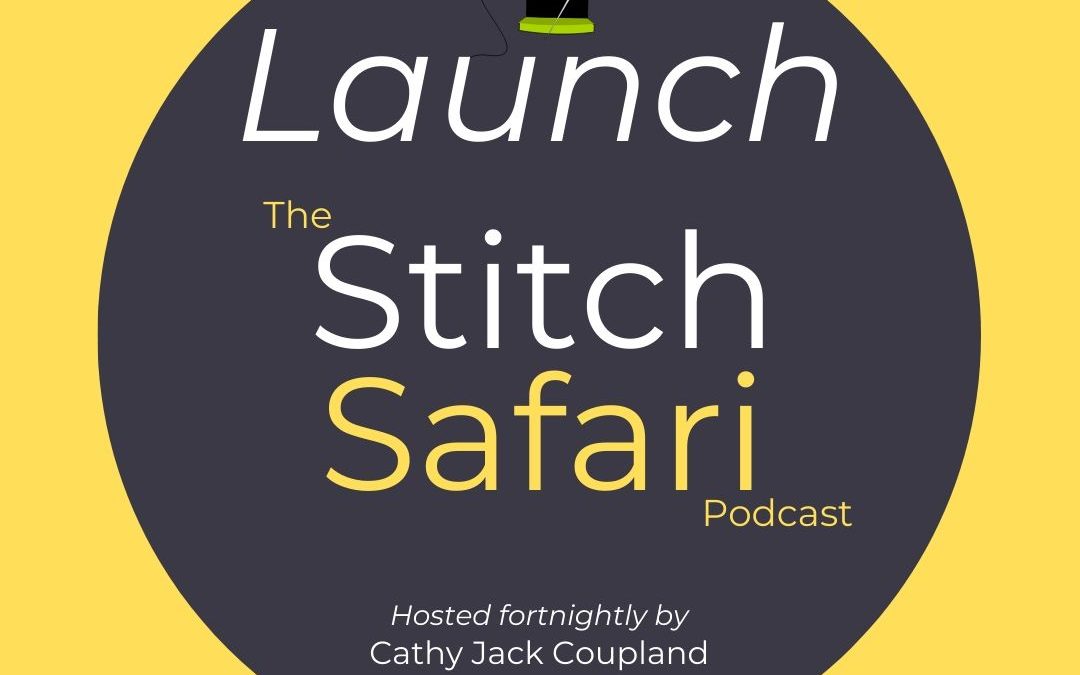‘Welcome to my refreshingly new adventure, honouring my passion for needle, thread and cloth.’
It’s time to hit the refresh button and do something just a little bit different. The Stitch Safari Podcast is a brand-new fortnightly expedition of mine, trekking through the development, applications, and innovations of cloth, needles, stitch, and embroidery. Join me as I host this light-hearted, informative tour dedicated to the art of the needle.
Right from the get-go, I’ve been seduced by the myths and legends, artwork, archaeology, poetry, and history of sewing with a needle and thread. It’s a rewardingly sustaining journey – there’s just so much to fascinate and inform, so this Podcast is my homage to the art of stitch and to the creativity of mankind throughout history.
Let me share some of the amazing snippets I’ve uncovered during research for my Podcasts. Yesterday, for instance, I immersed myself in some beautifully expressive Chinese poetry. One excerpt from the Book, Bo Wu Zhi by Zhang Hua, probably dating from the Song dynasty (960–1127) ‘beyond the South Sea there are shark people (mermaids) who live in the water like fish, but spin raw shark silk; when their eyes shed tears, weeping tears become pearls.’ He’s writing so imaginatively about Sea Silk.
Who’d have thought Leonardo da Vinci had anything to do with sewing. Well, he did. In 1496 Leonardo invented a machine to sharpen needles. Why? Because he thought it would make him rich. Remember, needles at this time were considered precious. The machine didn’t eventuate but thankfully Leonardo continued to create.
Now textiles are notoriously prone to deterioration, and many simply haven’t stood the test of time. But ancient artists captured numerous facets of decorative stitch used on dress, images of crop production for cloth, trade, and religious rites indicating a high level of importance in their daily lives. Move forward to the time of Elizabeth I and the unbelievably beautiful paintings highlighting the use of decorative stitch, applique, and lacework in her often sumptuous dress. Mind you. I think Charles I gave her a run for her money.
The Vikings also played their part. Imagine seeing a hoard of Viking long-boats, sails full to the wind, coming towards you. What did they use for those sails and how did they make and colour them?
In ancient times cloth was used to trade, pay taxes, and even pay wages. And look at the Vikings and those who came before them – cloth helped get them from A to B, harnessing the power of a breeze. Sericulture, the farming of silkworms for silk thread production was a long-held secret possessed only by the Chinese for centuries, before the opening of trade routes via The Silk Road. Cotton production in America presents the sustained growth of an already existing world-wide slave trade to satisfy a global need for ever-more cotton.
From Haute-Couture to royal regalia, from religious copes to incredible lace, leading onto a new ‘touch’ fabric designed to link to our phones. Along with the cultural and historical use of stitch and embroidery, handed down generationally, the world still revolves around cloth and stitch.
I’m just parting those lush tropical leaf fronds ever so slightly here, offering each of us a glance at a wonderful world – a world of needle, cloth, and thread.
Come on board. You can subscribe through Apple Podcasts, Apple iTunes, or Spotify, just search for The Stitch Safari Podcast. I’ve set up a Facebook page under the same name, where I’ll post the episodes each fortnight along with book reviews and any other useful info that comes my way. I plan to have guests. There’s a list an arm long, so we can hear from industry leaders, artists, and those just like you and me, who do it for pure love.
Get your hats and boots on – this Safari’s just beginning.

amazing tech-support Jess Jones of dotjess.com

